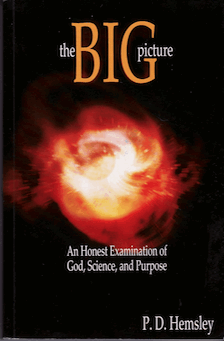
People believe in God, or disbelieve, for many different reasons. What convinces one person makes no impression on another.
So I am always interested in what convinces people, or not. And I am very interested in attempts people make to give an integrated and holistic explanation for belief.
Fellow blogger (Minimalist Christian) Phil Hemsley was a mild atheist until he was 40. But then he started considering the possible truth of the christian faith (you read his story on this website at A slow year’s journey into light) and eventually came to believe.
And now he has published a book, The Big Picture, giving his thinking on why he believes christianity to be true, and why he thinks others should consider it. So what’s it like?
A quick outline
The book follows some familiar paths for christian apologists, but with a few interesting variations. Main topics include:
- Truth, knowledge and faith (22 pages)
- Important discoveries in the physical and biological sciences (66 pages)
- Design and purpose (28 pages)
- God vs science (11 pages)
- Human experience (20 pages)
- Defining God (14 pages)
- Jesus and the New Testament (30 pages)
- Purpose in life and the way of the minimalist christian (44 pages)
Science and christian belief
It is clear from the space devoted to each topic that Phil is very committed to the value of modern science. The large section on science explains important findings in quantum physics, cosmology, biological evolution, molecular biology, DNA and human physiology. The explanations are generally well-written and easy to follow, but there are a few places where the detail seems more than necessary.
The length of this material (more than a quarter of the book) points up one of the strengths of Phil’s thinking – it is well-based in science, and you won’t find any sense of setting God against science.
Design and purpose
For me, this was one of the best sections of the book. Phil is a design engineer, holding many patents, so when he considers the information and design steps required to ‘design’ a human being, he brings considerable experience to the task. It turns out to be an even more complex task than I imagined.
He considers the number of generations of different species that natural selection utilised to reach where we are today, and concludes that evolution was amazingly fast. He concludes “the speed at which the evolutionary process has achieved its results all seem to me to be indicative of, or at least consistent with, a goal or purpose to the universe.”
Hard-line naturalistic evolutionists will not be happy with that conclusion, for they maintain (without any experiment I’m aware of on which to base the claim) that evolution was not guided nor did it have any goal. But I believe Phil’s careful statement, like others he makes throughout the book, is undogmatic, reflects what many people would wonder, and allows the reader to make up their own mind.
God and people
Phil suggests that such as subjective conscious experience, near death experiences, free will and experiences of God all point to God existing, and questions how love, goodness, justice and other virtues arise if they weren’t always there.
He also suggests that everything in creation, from the big bang to our sense of right and wrong and the suffering and evil in the world which we know as a consequence, are indicators of God’s character.
Jesus
His discussion about Jesus contains good information and covers familiar territory. I thought his ideas about ‘minimalist christianity’ as the appropriate response to Jesus were interesting.
Assessment
The Big Picture is a significant achievement. It discusses a broad sweep of ideas and is well researched. I personally thought some of the science was a little too detailed, but I liked the idea behind it.
Phil has presented well the reasons that eventually led him from atheism to minimalist christianity. I’d prefer the reasons for belief, especially the origin and design of the universe, which I regard as very convincing reasons, to have been presented more strongly. But Phil has taken a non-confrontational approach, trying (I presume) to present factual information, and ideas we might draw from that information, in a neutral manner, and leave the conclusions to the reader.
Therefore, I suspect strong atheists and christian apologists are both going to find this book a little less than convincing, but people who are wondering about God, want some food for thought but don’t want to buy into an argument, may well find it helpful.